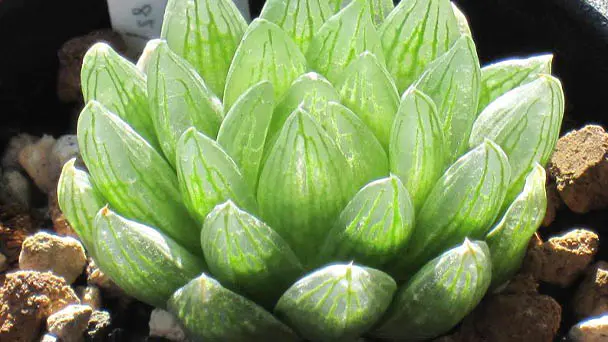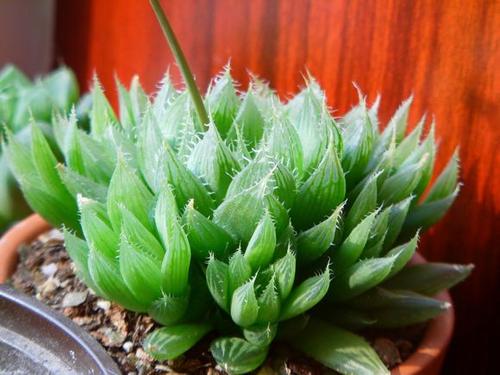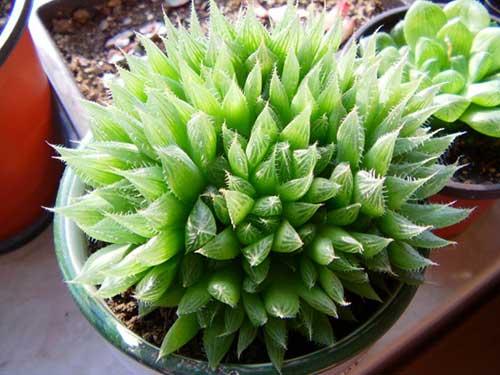Haworthia Cymbiformis Succulent Care Guide
Written by Maggie
Nov 10 2021

How to grow and care for Haworthia Cymbiformis? Potted Haworthia Cymbiformis looks like a pot of green fingers because its fleshy leaves stand up. Its unique shape and beautiful transparent leaves make it popular among succulent lovers. Now, let's talk about Haworthia cymbiformis care.
Haworthia Cymbiformis Light Care
When we care for Haworthia cymbiformis, it is necessary to let haworthia cymbiformis be exposed to more sunshine, so that its thick leaves look more green. Only when the sun is sufficient can Haworthia cymbiformis grow well. In summer, proper shade should be given to ensure that its leaves are dehydrated, dry and wilting.
When we care for Haworthia cymbiformis during the winter months, keep Haworthia cymbiformis in full sunlight at all times to keep its body warm and prevent its roots from getting frostbite or its leaves from turning yellow.
Haworthia Cymbiformis Watering
When we care for Haworthia cymbiformis, we need to give it proper water, but also to ensure the health of key spraying can not be too much water. If too much water, it will cause the yellow leaves, root rot, leaves to fall off, and even lead to blade completely no luster, winter to reduce to Haworthia cymbiformis water amount.
Because in the winter, if the soil water is too much, it will cause the roots of the plant frostbite or plant leaf blade frostbite, as ornamental effect will also have no, plants are also easy to die. When we grow and care for Haworthia cymbiformis in the summer, increase the watering amount, because summer moisture evaporates more quickly, so be sure to water less fertilizer.

Haworthia Cymbiformis Soil Care
Haworthia cymbiformis is less strict to the requirement of soil, as long as the growth in loose fertile, speculative and good drainage of sandy soil, and can live very well. When we care for Haworthia cymbiformis, we can choose to put some ceramsite in the soil, or rotten peanut shells, both to keep the soil nutrient, and can guarantee the permeability of soil permeability. When we grow and care for Haworthia cymbiformis, we can also choose to put some stones on the surface of soil in a basin, which can effectively lock in moisture, and also can enhance the Haworthia cymbiformis potted ornamental.
Haworthia Cymbiformis Pot
Haworthia cymbiformis requirement of flowerpot is nothing too big, just choose a relatively larger flowerpot. Because Haworthia cymbiformis is a kind of very easy basin meaty plant, when we grow and care for Haworthia cymbiformis, ensure that a year to give it in a pot, so that we can ensure that its root could be free of spread in the middle of the flower pots.

Haworthia Cymbiformis Temperature Care
Haworthia Cymbiformis grows fast in Spring and Autumn, when we need to pay attention to the temperature adjustment. Avoid too high or too low temperature, which will lead to Haworthia Cymbiformis into a dormant state. When the temperature is too high in summer, spray water into the basin to cool down the plant and put it in shade. High temperature and humidity will lead to the root rot of Haworthia Cymbiformis.Haworthia Cymbiformis Pest & Disease Control
Botrytis cinerea
The grayish brown spores of Botrytis cinerea are formed on the surface of fleshy leaves and flowers and can be easily identified. Gray mold is the most common disease in early spring or early summer when the weather is cool and humid. This Haworthia cymbiformis disease tends to grow in older, damaged or dead plant tissues and spread rapidly outward. Fungicides can be used as a preventive measure in places where gray mold is prevalent, but they cannot cure an infection. The affected site of this Haworthia cymbiformis disease requires removal and burning of damaged tissue. We'd better avoid watering succulent plants from the top, because it allows them to dry between watering and leaves no stumps when collecting cuttings.Leaf spot
This Haworthia cymbiformis disease has extensive tolerance to fungi causing leaf and stem spots. In most cases, these fungi are harmless, although they can seriously damage landscape plants. Light brown lesions appear on susceptible plants, causing permanent pitting or spots. A large number of infected succulent plants may spread the spots to other plants, but fungicides are generally not recommended.Wilt
The pathogen causing this Haworthia cymbiformis disease is Fusarium oxysporum. Fusarium wilt will interfere with the ability of succulent plants to absorb water, causing serious stress, wilting, yellowing and sometimes even death. This incurable soil borne fungus enters the plant through the root and begins to reproduce in vascular tissue. Eventually, these tissues are blocked, making it difficult or impossible for succulent plants to transport water. If the tissue is cut, you will see brown stripes. Keep good hygiene when using potted plants to prevent the spread of this Haworthia cymbiformis disease. Affected landscape plants are properly fed and watered to help them survive until they can grow new, unaffected tissues. In order to prevent the growth of fungi in the future, we continue to water carefully.Haworthia Cymbiformis Propagation
Haworthia Cymbiformis Cutting Propagation
We can use healthy branches to cut Haworthia cymbiformis. If it is round and full, we don't need to cut it twice. If it is a long branch, it can be cut into several sections, so that several more succulent trees will be cut. The leaves at the bottom of the branches and buds can be rolled off and planted. The cut branches can be placed in a cool and ventilated place and dried for 3 to 5 days, After the wound is dry and healed, it can be used for Haworthia cymbiformis cutting propagation. Multi meat cutting propagation does not really insert branches and buds into the soil. Cutting directly into the soil is easy to cause decay.Before Haworthia cymbiformis cutting propagation, we should wet the soil with water, and add a little carbendazim in the water to prevent it in advance. The wet soil is what we often call moist soil. This soil contains certain water, but will not be too wet and will not cause fleshy and rotten roots. The soil should be breathable and contain a certain proportion of particles, In this way, after rooting, it will not lead to ponding in the basin soil and reduce the risk of fleshy and rotten roots.
Haworthia Cymbiformis Division Propagation
The most commonly used method for maintaining the plant is division propagation. The best time for Haworthia cymbiformis division propagation is from April to may in the spring. During ramet propagation, select excellent and robust mother plants, and then cut them. Each part should have an independent root system, and then place them in a cool environment to dry, and then plant them after the wound becomes dry. After planting in Haworthia cymbiformis division propagation, we should pour water once, pay attention to keep the basin soil moist, and do not pour too much water on the plants just on the basin, so as not to cause plant decay; Wait until the plant has new roots and stems, and then water it normally.Haworthia Cymbiformis layering Propagation
Haworthia cymbiformis layering propagation is also a common propagation method. It does little damage to the meat. You can select healthy leaves at the bottom so that it will not affect the beauty of Haworthia cymbiformis. When breaking leaves, shake them left and right first. The action should be light. Do not damage the bud points on the leaves. They will not germinate without bud points, This is why Haworthia cymbiformis layering propagation does not germinate. Don't worry about putting the broken leaves into the basin first. We can put them in a ventilated place to dry for 5 days. At this time, the leaf wounds have dried up, some begin to wilt and soften, and are about to enter the state of rooting and germination.Haworthia Cymbiformis Benefits
The most common effect of Haworthia cymbiformis is to appreciate it. Its plants are exquisite and delicate, and its leaves are displayed neatly and orderly, like a lotus seat. Because of its common appearance and crystal like palm leaves, many people like to propagate haworthia cymbiformis in the bedroom. It is a kind of vegetation that can not only make the vision lose grip but also elegant.We put Haworthia cymbiformis on the computer desk. Maybe next to the TV can significantly receive radiation and maintain the activity of human cells. It not only decorates the TV and computer, but also maintains people's health. As a kind of succulent vegetation, Haworthia cymbiformis can not achieve the effect without polluting the atmosphere. Haworthia cymbiformis can receive carbon dioxide, carbon monoxide and other toxic gases in the atmosphere, differentiate them into oxygen and release them. Placing it in indoor propagation can make the atmosphere more refreshing.
Read More:
Haworthia cymbiformis profile
Latest Updated
- Benefits of Bugleweed - 7 Science-backed Health Benefits
- Bugleweed Dangers & Side Effects - Is It Poisonous?
- How to Plant Evergreen Trees - What You Should Know
- When to Plant Evergreens - Grow Guide for Evergreen Trees
- 12 Wonderful Evergreen Shrubs for Your Garden
- 12 Popular Evergreen Plants with Pictures for Beginners
- When And How To Prune A Lilac Bush Like a Pro
- How to Grow & Care for Lilac Vine (Hardenbergia Violacea)
- Japanese Lilac Tree (Syringa Reticulata) Care & Propagation Guide
- Shumard Oak Pros and Cons - What to Know
Popular Articles
- Winter maintenance of Antirrhinum Majus
- How to Grow Terminalia Mantaly Tree
- How to Grow and Care for Crossostephium Chinense
- How to grow Antirrhinum Majus in spring
- Peristeria Elata (Dove Orchid) Profile: Info & Care Guide
- Underwatered Snake Plant (Sansevieria Trifasciata) - Signs And How To Fix
- How to Care for Brazilian Jasmine Plant (Mandevilla Sanderi)
- How to Grow & Care for Graptopetalum Purple Delight in Summer
- Rosa Chinensis (China Rose): Plant Growing & Care Tips
- How to Care for Baby Sun Rose (Aptenia Cordifolia)